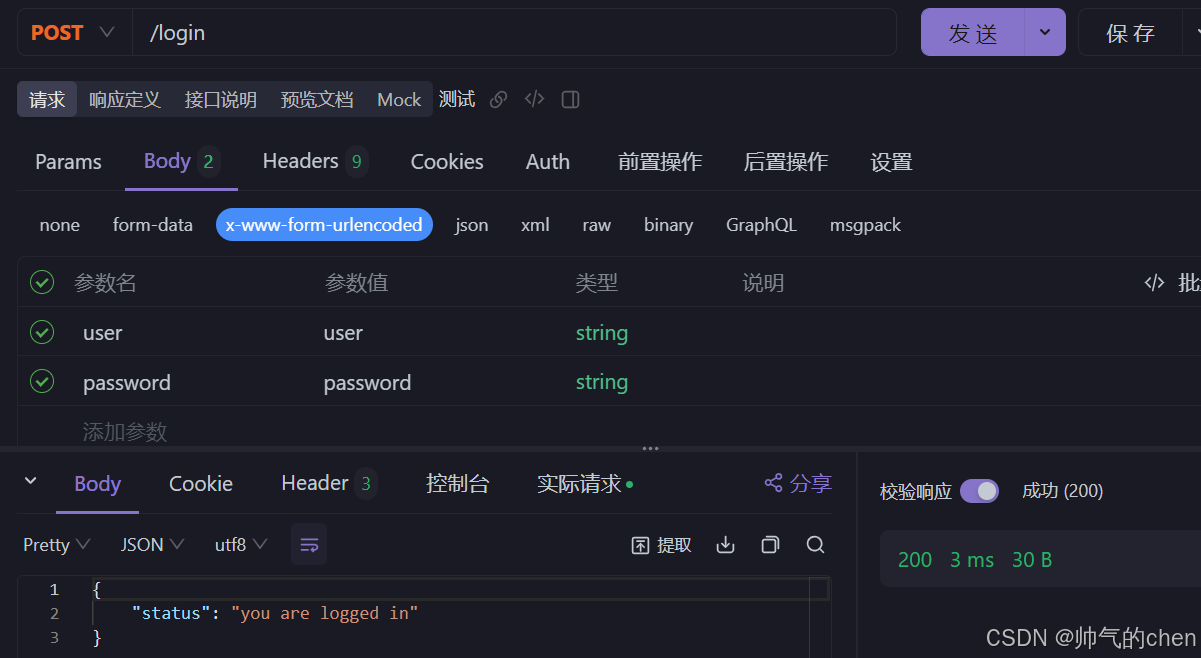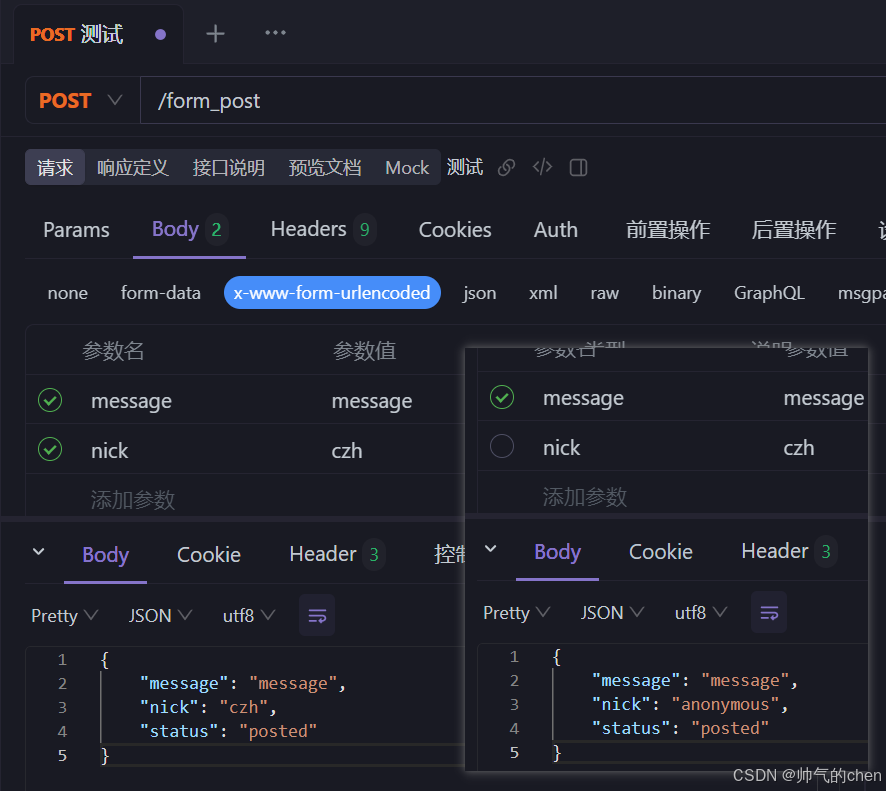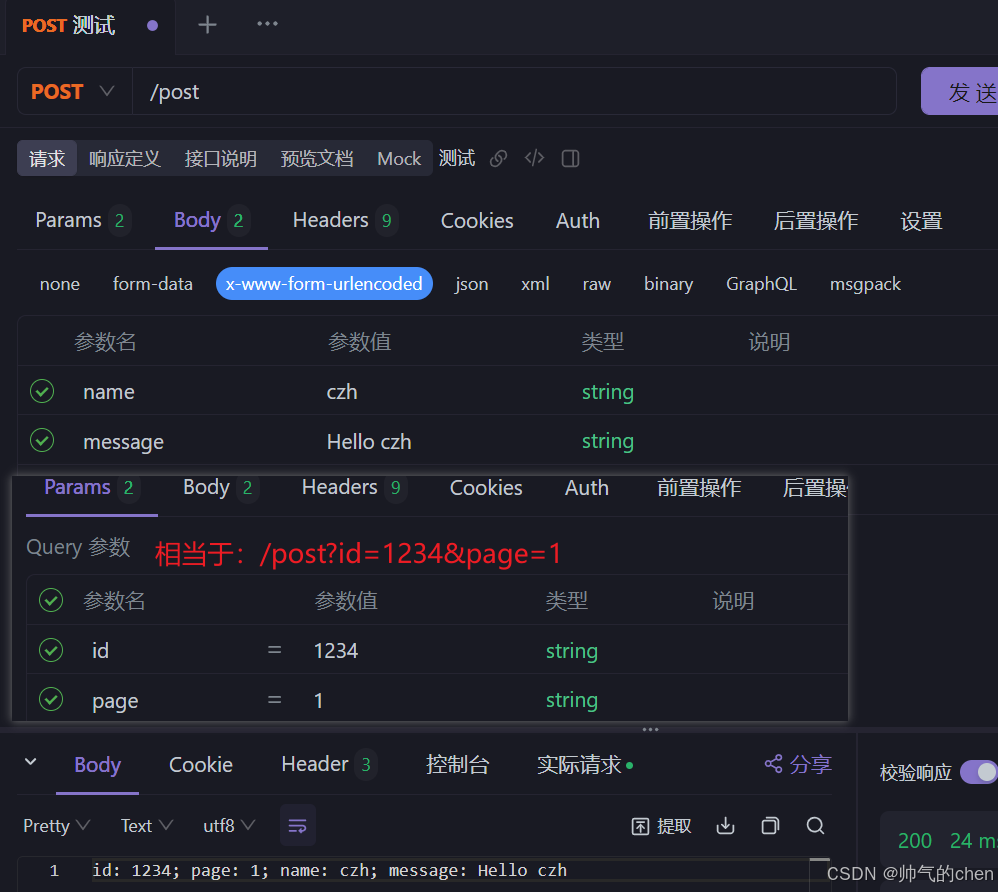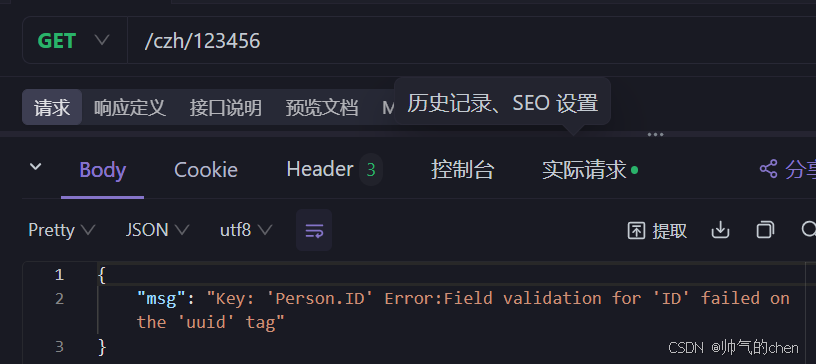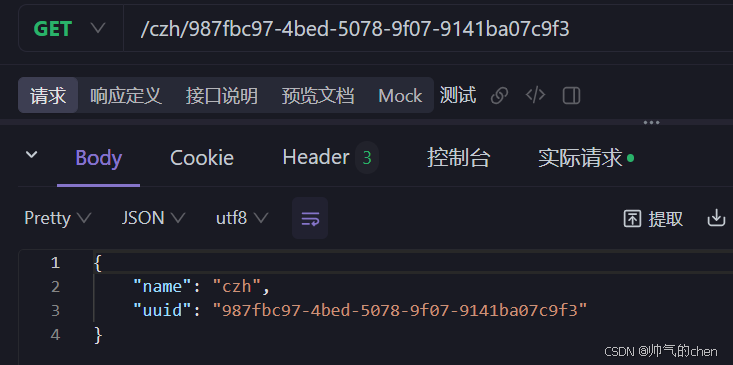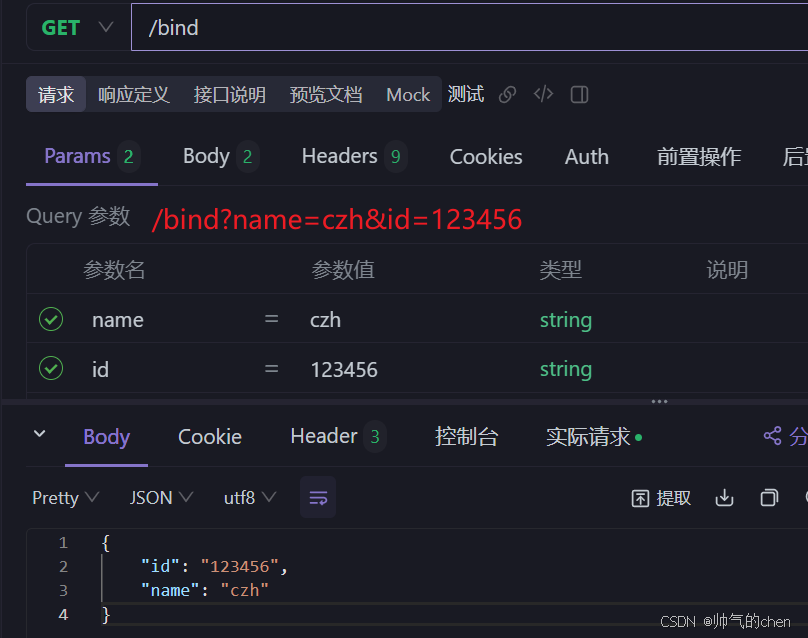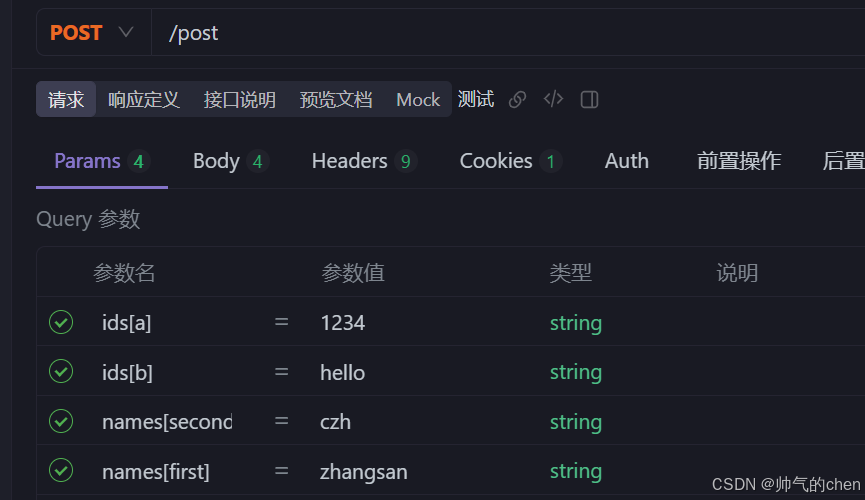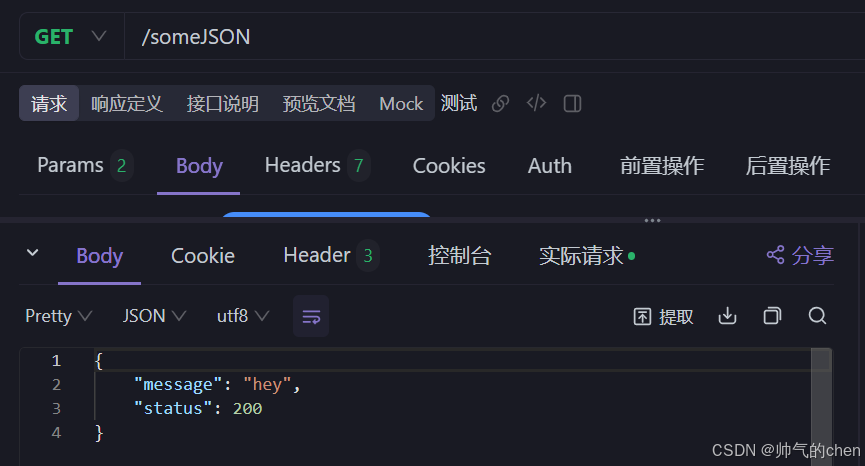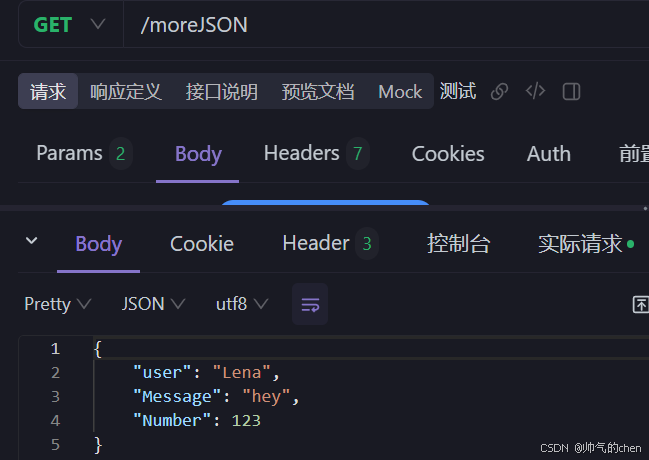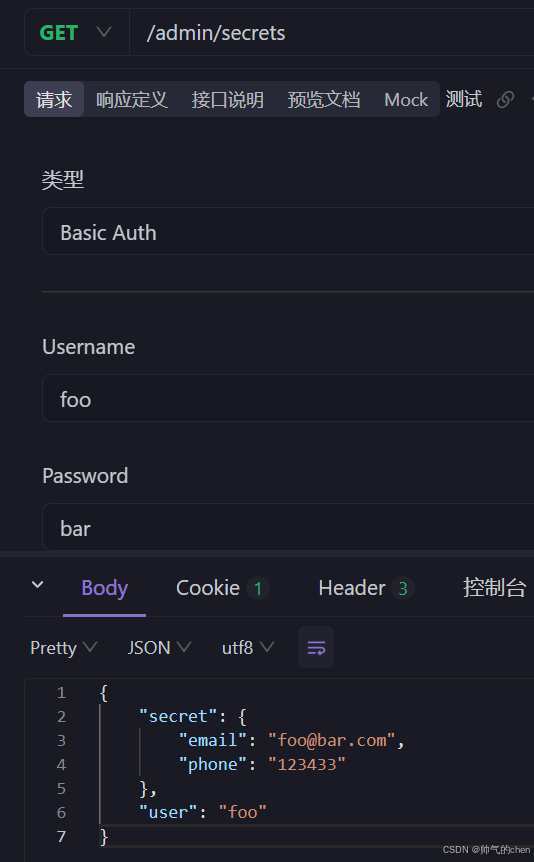Gin 是一个用 Go (Golang) 编写的 Web 框架。 它具有类似 martini 的 API,性能要好得多,多亏了 httprouter,速度提高了 40 倍。 如果您需要性能和良好的生产力,您一定会喜欢 Gin。
1.下载并安装 gin:
$ go get -u github.com/gin-gonic/gin
2.将 gin 引入到代码中:
import "github.com/gin-gonic/gin"
Gin常用绑定请求参数方式
Multipart/Urlencoded 绑定
ShouldBind
type LoginForm struct {
User string `form:"user" binding:"required"`
Password string `form:"password" binding:"required"`
}
func main() {
router := gin.Default()
router.POST("/login", func(c *gin.Context) {
// 你可以使用显式绑定声明绑定 multipart form:
// c.ShouldBindWith(&form, binding.Form)
// 或者简单地使用 ShouldBind 方法自动绑定:
var form LoginForm
// 在这种情况下,将自动选择合适的绑定
if c.ShouldBind(&form) == nil {
if form.User == "user" && form.Password == "password" {
c.JSON(200, gin.H{"status": "you are logged in"})
} else {
c.JSON(401, gin.H{"status": "unauthorized"})
}
}
})
router.Run(":8080")
}
// c.ShouldBind 使用了 c.Request.Body,不可重用。 if errA := c.ShouldBind(&objA); errA == nil { c.String(http.StatusOK, `the body should be formA`) // 因为现在 c.Request.Body 是 EOF,所以这`在这里插入代码片`里会报错。 } else if errB := c.ShouldBind(&objB); errB == nil { c.String(http.StatusOK, `the body should be formB`) } else { ... }要想多次绑定,可以使用
c.ShouldBindBodyWith.func SomeHandler(c *gin.Context) { objA := formA{} objB := formB{} // 读取 c.Request.Body 并将结果存入上下文。 if errA := c.ShouldBindBodyWith(&objA, binding.JSON); errA == nil { c.String(http.StatusOK, `the body should be formA`) // 这时, 复用存储在上下文中的 body。 } else if errB := c.ShouldBindBodyWith(&objB, binding.JSON); errB == nil { c.String(http.StatusOK, `the body should be formB JSON`) // 可以接受其他格式 } else if errB2 := c.ShouldBindBodyWith(&objB, binding.XML); errB2 == nil { c.String(http.StatusOK, `the body should be formB XML`) } else { ... } }
c.ShouldBindBodyWith会在绑定之前将 body 存储到上下文中。 这会对性能造成轻微影响,如果调用一次就能完成绑定的话,那就不要用这个方法。- 只有某些格式需要此功能,如
JSON,XML,MsgPack,ProtoBuf。 对于其他格式, 如Query,Form,FormPost,FormMultipart可以多次调用c.ShouldBind()而不会造成任任何性能损失
Multipart/Urlencoded 表单
PostForm&DefaultPostForm
func main() {
router := gin.Default()
router.POST("/form_post", func(c *gin.Context) {
message := c.PostForm("message")
nick := c.DefaultPostForm("nick", "anonymous")
c.JSON(200, gin.H{
"status": "posted",
"message": message,
"nick": nick,
})
})
router.Run(":8080")
}
Query 和 post form
Query&DefaultQuery
func main() {
router := gin.Default()
router.POST("/post", func(c *gin.Context) {
id := c.Query("id")
page := c.DefaultQuery("page", "0")
name := c.PostForm("name")
message := c.PostForm("message")
sprintf := fmt.Sprintf("id: %s; page: %s; name: %s; message: %s", id, page, name, message)
c.String(http.StatusOK, sprintf)
})
router.Run(":8080")
}
绑定 Uri
/:
type Person struct {
ID string `uri:"id" binding:"required,uuid"`
Name string `uri:"name" binding:"required"`
}
func main() {
route := gin.Default()
route.GET("/:name/:id", func(c *gin.Context) {
var person Person
if err := c.ShouldBindUri(&person); err != nil {
c.JSON(400, gin.H{"msg": err.Error()})
return
}
c.JSON(200, gin.H{"name": person.Name, "uuid": person.ID})
})
route.Run(":8080")
}
Param
func main() {
router := gin.Default()
// 此 handler 将匹配 /user/john 但不会匹配 /user/ 或者 /user
router.GET("/user/:name", func(c *gin.Context) {
name := c.Param("name")
c.String(http.StatusOK, "Hello %s", name)
})
// 此 handler 将匹配 /user/john/ 和 /user/john/send
// 如果没有其他路由匹配 /user/john,它将重定向到 /user/john/
router.GET("/user/:name/*action", func(c *gin.Context) {
name := c.Param("name")
action := c.Param("action")
message := name + " is " + action
c.String(http.StatusOK, message)
})
router.Run(":8080")
}
绑定表单数据至自定义结构体
bind(&)
type Person struct {
Name string `form:"name"`
Id string `form:"id"`
}
func main() {
r := gin.Default()
r.GET("/bind", func(c *gin.Context) {
var p Person
c.Bind(&p)
c.JSON(http.StatusOK, gin.H{"name": p.Name, "id": p.Id})
})
r.Run(":8080")
}
Gin提供了两类绑定方法:
Type
- Must bind
- Methods -
Bind,BindJSON,BindXML,BindQuery,BindYAML- Behavior - 这些方法属于
MustBindWith的具体调用。 如果发生绑定错误,则请求终止,并触发c.AbortWithError(400, err).SetType(ErrorTypeBind)。响应状态码被设置为 400 并且Content-Type被设置为text/plain; charset=utf-8。 如果您在此之后尝试设置响应状态码,Gin会输出日志[GIN-debug] [WARNING] Headers were already written. Wanted to override status code 400 with 422。 如果您希望更好地控制绑定,考虑使用ShouldBind等效方法。Type
- Should bind
- Methods -
ShouldBind,ShouldBindJSON,ShouldBindXML,ShouldBindQuery,ShouldBindYAML- Behavior - 这些方法属于
ShouldBindWith的具体调用。 如果发生绑定错误,Gin 会返回错误并由开发者处理错误和请求。使用 Bind 方法时,Gin 会尝试根据 Content-Type 推断如何绑定。 如果你明确知道要绑定什么,可以使用
MustBindWith或ShouldBindWith。
映射查询字符串或表单参数
QueryMap&PostFormMap
func main() {
router := gin.Default()
router.POST("/post", func(c *gin.Context) {
ids := c.QueryMap("ids")
names := c.PostFormMap("names")
fmt.Printf("ids: %v; names: %v", ids, names)
})
router.Run(":8080")
}
Gin常用返回参数方式
JSON渲染
func main() {
r := gin.Default()
// gin.H 是 map[string]interface{} 的一种快捷方式
r.GET("/someJSON", func(c *gin.Context) {
c.JSON(http.StatusOK, gin.H{"message": "hey", "status": http.StatusOK})
})
r.GET("/moreJSON", func(c *gin.Context) {
// 你也可以使用一个结构体
var msg struct {
Name string `json:"user"`
Message string
Number int
}
msg.Name = "Lena"
msg.Message = "hey"
msg.Number = 123
// 注意 msg.Name 在 JSON 中变成了 "user"
// 将输出:{"user": "Lena", "Message": "hey", "Number": 123}
c.JSON(http.StatusOK, msg)
})
}
路由组
func main() {
router := gin.Default()
// 简单的路由组: v1
v1 := router.Group("/v1")
{
v1.POST("/login", loginEndpoint)
v1.POST("/submit", submitEndpoint)
v1.POST("/read", readEndpoint)
}
// 简单的路由组: v2
v2 := router.Group("/v2")
{
v2.POST("/login", loginEndpoint)
v2.POST("/submit", submitEndpoint)
v2.POST("/read", readEndpoint)
}
router.Run(":8080")
}
上传文件
单文件
func main() {
router := gin.Default()
// 为 multipart forms 设置较低的内存限制 (默认是 32 MiB)
router.MaxMultipartMemory = 8 << 20 // 8 MiB
router.POST("/upload", func(c *gin.Context) {
// 单文件
file, _ := c.FormFile("file")
log.Println(file.Filename)
dst := "./" + file.Filename
// 上传文件至指定的完整文件路径
c.SaveUploadedFile(file, dst)
c.String(http.StatusOK, fmt.Sprintf("'%s' uploaded!", file.Filename))
})
router.Run(":8080")
}
如何使用 curl:
curl -X POST http://localhost:8080/upload \
-F "file=@/Users/appleboy/test.zip" \
-H "Content-Type: multipart/form-data"
多文件
func main() {
router := gin.Default()
// 为 multipart forms 设置较低的内存限制 (默认是 32 MiB)
router.MaxMultipartMemory = 8 << 20 // 8 MiB
router.POST("/upload", func(c *gin.Context) {
// Multipart form
form, _ := c.MultipartForm()
files := form.File["upload[]"]
for _, file := range files {
log.Println(file.Filename)
// 上传文件至指定目录
dst := "./" + file.Filename
c.SaveUploadedFile(file, dst)
}
c.String(http.StatusOK, fmt.Sprintf("%d files uploaded!", len(files)))
})
router.Run(":8080")
}
如何使用 curl:
curl -X POST http://localhost:8080/upload \
-F "upload[]=@/Users/appleboy/test1.zip" \
-F "upload[]=@/Users/appleboy/test2.zip" \
-H "Content-Type: multipart/form-data"
设置Cookie
func main() {
router := gin.Default()
router.GET("/cookie", func(c *gin.Context) {
cookie, err := c.Cookie("gin_cookie")
if err != nil {
cookie = "NotSet"
c.SetCookie("gin_cookie", "test", 3600, "/", "localhost", false, true)
}
fmt.Printf("Cookie value: %s \n", cookie)
//Cookie value: 123456
})
router.Run()
}
使用BasicAuth中间件
// 模拟一些私人数据
var secrets = gin.H{
"foo": gin.H{"email": "[email protected]", "phone": "123433"},
"austin": gin.H{"email": "[email protected]", "phone": "666"},
"lena": gin.H{"email": "[email protected]", "phone": "523443"},
}
func main() {
r := gin.Default()
// 路由组使用 gin.BasicAuth() 中间件
// gin.Accounts 是 map[string]string 的一种快捷方式
authorized := r.Group("/admin", gin.BasicAuth(gin.Accounts{
"foo": "bar",
"austin": "1234",
"lena": "hello2",
"manu": "4321",
}))
// /admin/secrets 端点
// 触发 "localhost:8080/admin/secrets
authorized.GET("/secrets", func(c *gin.Context) {
// 获取用户,它是由 BasicAuth 中间件设置的
user := c.MustGet(gin.AuthUserKey).(string)
if secret, ok := secrets[user]; ok {
c.JSON(http.StatusOK, gin.H{"user": user, "secret": secret})
} else {
c.JSON(http.StatusOK, gin.H{"user": user, "secret": "NO SECRET :("})
}
})
// 监听并在 0.0.0.0:8080 上启动服务
r.Run(":8080")
}
在中间件中使用 Goroutine
c.Copy()
当在中间件或 handler 中启动新的 Goroutine 时,不能使用原始的上下文,必须使用只读副本。
func main() {
r := gin.Default()
r.GET("/long_async", func(c *gin.Context) {
// 创建在 goroutine 中使用的副本
cCp := c.Copy()
go func() {
// 用 time.Sleep() 模拟一个长任务。
time.Sleep(5 * time.Second)
// 请注意您使用的是复制的上下文 "cCp",这一点很重要
log.Println("Done! in path " + cCp.Request.URL.Path)
}()
})
r.GET("/long_sync", func(c *gin.Context) {
// 用 time.Sleep() 模拟一个长任务。
time.Sleep(5 * time.Second)
// 因为没有使用 goroutine,不需要拷贝上下文
log.Println("Done! in path " + c.Request.URL.Path)
})
// 监听并在 0.0.0.0:8080 上启动服务
r.Run(":8080")
}
重定向
HTTP 重定向很容易。 内部、外部重定向均支持。
r.GET("/test", func(c *gin.Context) {
c.Redirect(http.StatusMovedPermanently, "http://www.google.com/")
})
通过 POST 方法进行 HTTP 重定向。
r.POST("/test", func(c *gin.Context) {
c.Redirect(http.StatusFound, "/foo")
})
路由重定向,使用 HandleContext:
r.GET("/test", func(c *gin.Context) {
c.Request.URL.Path = "/test2"
r.HandleContext(c)
})
r.GET("/test2", func(c *gin.Context) {
c.JSON(200, gin.H{"hello": "world"})
})
自定义 HTTP 配置
直接使用 http.ListenAndServe(),如下所示:
import "net/http"
func main() {
router := gin.Default()
http.ListenAndServe(":8080", router)
}
或
import "net/http"
func main() {
router := gin.Default()
s := &http.Server{
Addr: ":8080",
Handler: router,
ReadTimeout: 10 * time.Second,
WriteTimeout: 10 * time.Second,
MaxHeaderBytes: 1 << 20,
}
s.ListenAndServe()
}
其他
不使用默认中间件
r := gin.New()
// 使用gin.New()代替
// Default 使用 Logger 和 Recovery 中间件
r := gin.Default()
强制日志颜色化
// 强制日志颜色化
gin.ForceConsoleColor()
